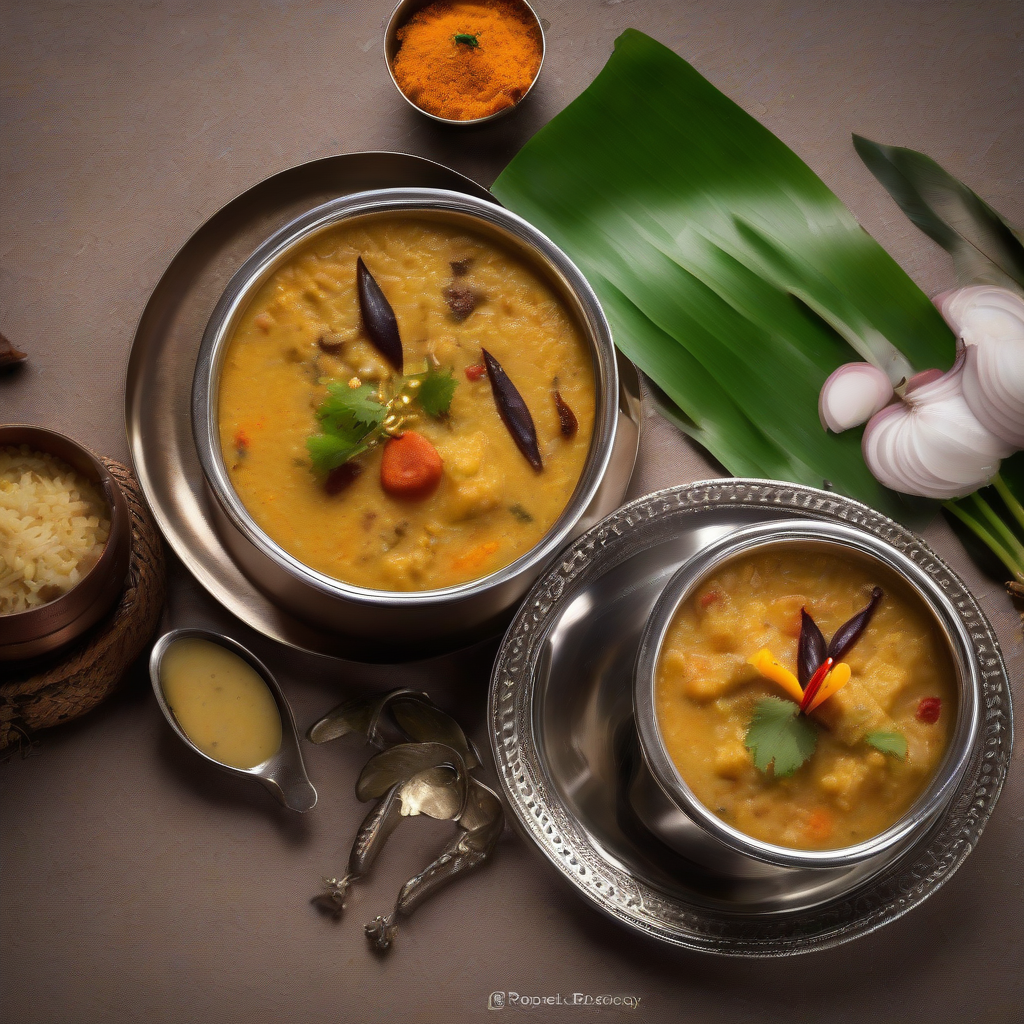Pongal Pandemonium: A South Indian Staple That’ll Warm Your Soul, Yaar!
Namaste and Vanakkam, my foodie friends! Chef Curry Do’pyaza here, ready to whisk you away on a culinary adventure to the sunny shores of South India! Today, we’re diving deep into the deliciousness of Pongal with Sambar, a dish that’s as comforting as a warm hug on a chilly winter morning.
This isn’t just food, folks, it’s a celebration on a plate!
When the Pongal Pot Bubbles Over:
Pongal, the dish, is synonymous with Pongal, the festival! This vibrant harvest festival, celebrated with gusto in Tamil Nadu and other parts of South India, usually falls in mid-January. It marks the end of the winter solstice and the beginning of Uttarayanam, the sun’s journey northwards. Families gather, decorate their homes with colorful kolams (rangoli), and, of course, cook up a storm! Pongal is also a daily breakfast staple in many South Indian homes.
A Glimpse into History’s Kitchen:
Pongal, in its simplest form, has been around for centuries. References to a rice and lentil dish can be found in ancient Tamil literature. Over time, it evolved into the sweet and savory versions we know and love today. Each family has their own special twist, passed down through generations.
Let’s Get Cooking!
Preparation Time: 15 minutes
Cooking Time: 45 minutes
The Star-Studded Cast (Ingredients):
For the Ven Pongal (Savory Pongal):
- 1/2 cup Pachai Arisi (Raw Rice)
- 1/4 cup Paasi Paruppu (Moong Dal)
- 4 cups Thanni (Water)
- 1 teaspoon Jeeragam (Cumin Seeds)
- 1/2 teaspoon Milagu (Black Peppercorns), coarsely crushed
- 1 inch piece Inji (Ginger), finely grated
- 1/4 teaspoon Perungayam (Asafoetida)
- 2 tablespoons Neyyi (Ghee)
- Salt to taste
For the Sambar (Lentil and Vegetable Stew):
- 1/2 cup Thuvaram Paruppu (Toor Dal)
- 2 cups Thanni (Water)
- 1 cup assorted vegetables, chopped (Drumstick, Pumpkin, Eggplant, Okra, Carrot, Onion)
- 1 medium size Thakkali (Tomato), chopped
- 1 small size Vengayam (Onion), chopped
- 1 teaspoon Sambar Podi (Sambar Powder)
- 1/4 teaspoon Manjal Podi (Turmeric Powder)
- A small piece of Puli (Tamarind), soaked in 1/2 cup of warm water
- Salt to taste
For the Sambar Tempering:
- 1 tablespoon Ennai (Oil)
- 1/2 teaspoon Kadugu (Mustard Seeds)
- 1/2 teaspoon Jeeragam (Cumin Seeds)
- 1 pinch Perungayam (Asafoetida)
- 2 dry red chillies, broken into pieces
- Few Kariveppilai (Curry Leaves)
Let the Magic Begin (Instructions):
Ven Pongal:
- Wash and Shine: Gently wash the rice and moong dal together until the water runs clear.
- Pressure Cooker Power: In a pressure cooker, combine the washed rice and dal with 4 cups of water. Add salt, asafoetida, grated ginger, cumin seeds, and crushed peppercorns.
- Whistle While You Cook: Close the pressure cooker and cook for 3-4 whistles on medium heat. Let the pressure release naturally.
- Ghee-licious Touch: Open the cooker and mash the pongal lightly with a spoon. Add ghee and mix well. Keep warm.
Sambar:
- Dal Delight: Wash the toor dal and cook it in a pressure cooker with 2 cups of water and a pinch of turmeric powder for 2-3 whistles. Mash the cooked dal well.
- Veggie Symphony: In a pot, combine the chopped vegetables, chopped tomato, chopped onion, sambar powder, turmeric powder, and salt. Add 1 cup of water and cook until the vegetables are tender.
- Tamarind Tango: Squeeze the tamarind pulp from the soaked tamarind water and add it to the vegetables. Simmer for a few minutes.
- Dal Meets Veggies: Add the mashed dal to the vegetable mixture. Adjust the consistency by adding more water if needed. Bring to a simmer.
- Tempering Triumph: In a small pan, heat oil. Add mustard seeds, cumin seeds, asafoetida, dry red chillies, and curry leaves. Let the mustard seeds splutter. Pour this tempering over the sambar.
Chef’s Secret Spices (Tips for Best Results):
- Ghee is Gold: Don’t skimp on the ghee! It adds a rich, nutty flavor that elevates the Pongal to another level.
- Fresh is Best: Use fresh ingredients whenever possible. The flavor difference is remarkable.
- Spice it Up (or Down): Adjust the amount of black pepper and sambar powder to suit your taste.
- Consistency is Key: Pongal should be soft and slightly mushy. Sambar should be thick but pourable.
Cooking Style Versatility:
- Gas Stove/Induction Stove: Follow the instructions above using a pot and pressure cooker.
- Pressure Cooker: You can cook the Pongal and Sambar in separate pressure cookers simultaneously to save time.
- Slow Cooker/Crockpot: For Pongal, combine all ingredients in the slow cooker and cook on low for 4-6 hours. For Sambar, cook the dal and vegetables separately, then combine and simmer in the slow cooker.
- Microwave: Not recommended for best results, but you can microwave the Pongal in short bursts, stirring in between, until heated through. Sambar can be reheated in the microwave.
- Oven/Air Fryer: Not applicable for this recipe.
Nourishment Nuggets (Nutritional Information – Approximate):
(Per serving, estimates may vary)
- Calories: 350-400
- Protein: 15-20g
- Carbohydrates: 50-60g
- Fat: 10-15g
Serving Suggestions:
Serve the hot, fluffy Ven Pongal with a generous ladle of flavorful Sambar. A dollop of ghee on top of the Pongal is always a welcome addition! You can also serve it with coconut chutney or vadai (lentil fritters) for a complete South Indian experience.
Your Turn to Shine!
So there you have it, my friends! A simple yet satisfying recipe for Pongal with Sambar that’s sure to become a family favorite. Now, go forth and create some culinary magic in your own kitchen! Let the aroma of spices fill your home and the flavors transport you to the heart of South India.
Go on, give it a try, and let me know how it turns out! Happy cooking!
